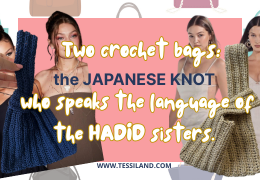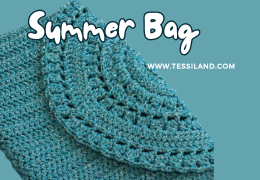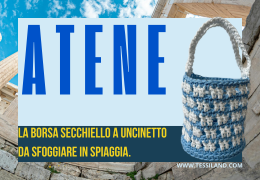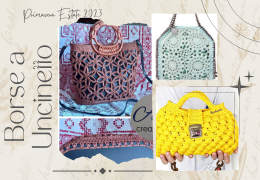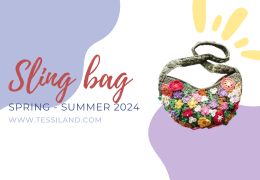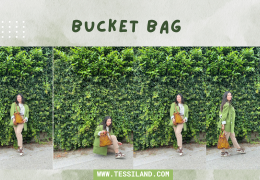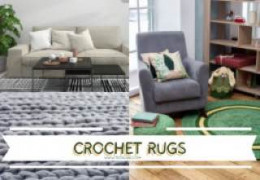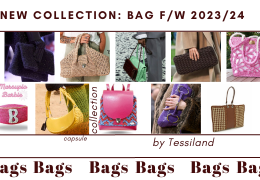Two bags, two styles, one single trend. The Japanese knot takes over summer 2025 with two irresistible crochet...
Handmade jewelry, a world to discover.
Raise your hand if at least once, while scrolling through your social media feed, you haven't come across a video or photo related to handmade jewelry making.
For spring/summer 2023, they are a real trend to show off, both among the very young and the more mature. So let's discover together the origins, some curiosities about it, and all the tools needed to delve into this new crafting technique.
Differences between jewelry and bijoux.
.png)
It is essential to start from the basics to understand what it is all about.
Did you know that there is a difference between JEWELRY and BIJOUX?
Let's discover it together:
The term "jewel" refers to a precious object made with materials such as gold, silver, diamonds, precious stones, and other gems. Jewelry is often associated with high-quality, valuable pieces made by designers or luxury brands.
The term "bijoux", on the other hand, refers to a piece of jewelry that imitates the appearance of fine jewelry but is made with less precious materials, such as plastic, plated metal, crystals, glass beads, etc. Bijoux are often fashion accessories that are trendy and less expensive than real jewelry.
Without taking anything away from original craftsmanship and expressions of creativity, anything that does not involve working with silver, gold, palladium, and titanium does not fall into the category of "precious".
What are bijoux?
.png)
Bijoux are a type of fashion jewelry that differs from fine jewelry due to their affordable price and less complex craftsmanship. They are generally made with less precious materials, such as plated metals, rhinestones, synthetic pearls, crystals, and can be decorated with artificial stones or design elements such as pearl threads, tassels, chains, fabric strips, and so on. Bijoux are often used as fashion accessories and can be worn to complete an outfit or to add a touch of elegance or originality to it.
Meaning of the Term.
.png)
Non-precious materials (costume jewelry) pretty thing, with the same uses as its adaptation.
The word "bijoux" is of French origin and means "jewelry" in Italian. It refers to ornamental objects such as rings, necklaces, bracelets, earrings, and other similar fashion accessories. Generally, the term "bijoux" is used to describe small, delicate pieces of jewelry, often decorated with stones or beads, and can be worn by both men and women.
In some contexts, the word "bijoux" can be used figuratively to describe something rare or valuable, not necessarily a piece of jewelry.
History of bijoux.
.png)
The history of bijoux, or costume jewelry as it is often called, is closely linked to the history of fine jewelry. The term "bijoux" comes from French and was first used in the 18th century to describe high-fashion jewelry.
However, the term "costume jewelry" generally refers to less expensive fashion jewelry, often made with materials such as plastic, glass, common metals, and imitation stones. Costume jewelry became popular in the 19th century, when the mass production of inexpensive jewelry made fashion items accessible to a wider audience.
During the Belle Époque (late 19th - early 20th century), costume jewelry was considered an art form, and many high-end jewelry designers also created high-quality bijoux. However, with the advent of low-cost mass production, costume jewelry became increasingly accessible and popular.
In the 1960s and 70s, costume jewelry became a hallmark of the hippie movement, with beaded bracelets and handmade necklaces becoming a must-have for alternative fashion enthusiasts. Today, costume jewelry is still very popular and is made in a wide range of styles and materials, from high-fashion bijoux to unique handmade pieces.
Styles of bijoux.
.png)
There are different styles in this world, as it is a personal detail, it varies from look to look, from style to style.
Let's discover together the most well-known styles of bijoux:
- Classic: bijoux with an elegant, refined, and sophisticated look.
- Boho: bijoux with a bohemian atmosphere, inspired by gypsy and hippie culture.
- Minimalist: simple, clean, and minimalistic bijoux.
- Vintage: bijoux inspired by the past, such as the 1920s, 30s, and 40s.
- Modern: bijoux with a contemporary, innovative, and bold design.
- Gothic: bijoux with a dark atmosphere, inspired by gothic culture and horror literature.
- Ethnic: bijoux inspired by the culture and traditions of indigenous peoples and tribes.
- Glamour: sparkling, eye-catching, and luxurious bijoux.
- Geometric: bijoux with geometric shapes such as circles, squares, and triangles.
- Natural: bijoux made with natural materials such as wood, stones, shells, and other elements of nature.
How to wear bijoux?
.png)
There are many unwritten rules when it comes to wearing bijoux, but generally, it's about choosing pieces that match your personal style and using them in a balanced way. Here are some tips for wearing bijoux:
- Choose the bijoux according to the occasion: for a formal occasion, choose elegant and subtle bijoux, while for an informal event, you can dare with larger and more eye-catching pieces.
- Don't overdo it: wear a maximum of three bijoux at any one time. Also, try to balance the sizes of the pieces. If you wear large earrings, avoid wearing a flashy necklace.
- Match the bijoux to the colors of your outfit: for example, if you're wearing a blue shirt, you can choose gold or silver bijoux.
- Experiment: don't be afraid to experiment with different types of bijoux. You can mix and match different styles and materials to create a unique look.
- Follow your instinct: finally, remember that fashion is subjective and what works for someone else might not work for you. Follow your instinct and choose the bijoux that make you feel comfortable and confident.
Making handmade bijoux.
.png)
There are certainly many reasons why it might be advantageous to make handmade bijoux instead of buying an industrially produced jewel.
Ecco la traduzione in inglese con il codice HTML invariato e la sostituzione di /it/ con /en/ dove necessario:
Assorted Needles
Assortment of 25 fine needles for embroidery and beading, as well as for full stitches and cross stitches in a plum blue box with a dispenser. The tempered steel needles have balanced elasticity and a burr-free eye. The symbols for the different embroideries are printed on the transparent cover above the individual compartments. As a result, the needles can always be correctly assigned and organized. Each of the five compartments, each containing 5 specific needles, can be opened and secured with a separate closure.
Beading Needles
The ultrafine needles, made with thin steel threads and very small eyes, are suitable for sewing applications, strass, as well as beading. Despite their remarkable flexibility, the needles remain stable without bending or breaking. Prym offers beading needles in sizes 10 and 12.
Pliers
The pliers used for making bijoux are useful tools for manipulating the materials used in creating handmade jewelry. There are different types of pliers, each of which has a specific function.
Bijoux Closures, Hooks, Lobster Clasp, Earrings, Pins
Charms, hooks, rings, beads, ring bases, and everything you need to make your own DIY jewelry
Guide to choosing beads.
Beads
Hobbies and beads have been a well-established pair for years. We see more and more enthusiasts approaching this particular hobby for costume jewelry. However, it is also true that we see many types of beads for necklaces, beads for bracelets, and beads for bijoux in general, and it is not always easy to choose, so it is necessary to clarify a bit.
Which beads to choose for costume jewelry?
Of course, there are many qualities of beads for costume jewelry and very often, it is only after making our piece that we can judge the brilliance, colors, and durability over time, but there is a solution! Trust Italian companies like Tessiland that, without any intermediaries, offer the best quality at the best possible price. The second parameter is undoubtedly the assortment and the guarantee of re-supply, and this has always been guaranteed by Tessiland!
But how many types of beads exist?
The list could be very long, because beads, like any fashion accessory, are subject to cycles in fashion and are enriched each year with shapes, sizes, and shades. However, it is possible to list the most popular ones:
Prism bead in 4 sizes and over 100 colors per size: prism-shaped beads with a mirrored effect
Cubik bead: parallelepiped-shaped beads with a marbled effect
Drop bead: drop-shaped beads with a mirrored crystal effect
Gloss beads: precious ceramic beads with the typical majolica effect
Mat beads: resin beads with very fresh colors and a matte effect
Tropic beads: precious glass beads with a shiny and antiqued effect
Silk beads: resin beads also called Miyuki beads
Glass beads: glass beads with a special treatment to enhance the shine
Mix wood beads: wooden beads particularly suitable for bracelets and necklaces
The list would be even longer and continually evolving, but this is an excellent starting point if you do not want to rely on the already available different shades to start having fun in this wonderful world of bijoux.
Ecco la traduzione in inglese con il codice HTML invariato e la sostituzione di /it/ con /en/ dove necessario: ```html
Between half crystal, Chinese crystal, colored beads, white beads, and hard stones, the limit is always your imagination. But let's delve into these types:
Half crystals, for example, have Bohemian origins and were already used to replace precious stones, imitating their shape and brightness. They are made of glass and fire-polished to achieve an appearance as close as possible to a precious stone.
Chinese Crystals can be misleading by their name, because we are somewhat used to associating the place of manufacture with poor quality, but in this case, it should be noted that the product is of fine quality at a very affordable price, which allows, for example, to create even large-sized pieces.
There are also wooden spheres that can be classified among wooden beads but are more often used for Christmas gadgets, reaching diameters of up to 8 centimeters.
Discover the beads by Tessiland:
Charms
Charms for jewelry are small decorative objects used to personalize bracelets, necklaces, earrings, and other types of bijoux. They usually have a specific shape and design, such as symbols, animal figures, flowers, hearts, letters, etc.
Charms can be made from various materials, including precious metals like gold and silver, but also wood, glass, ceramics, precious stones, beads, crystals, and other materials. They are often used as gifts or as tokens of affection or appreciation for a loved one.
After the spread of ''pandora'' models, there are really many ideas available on our site to make your bijoux even more personal...
Let's discover all the types of charms in our catalog:
How to start making DIY jewelry?
Social media and particularly Youtube remain the most practical and immediate sources with free patterns, ironing bead patterns, and bead tutorials, but if you want to delve deeper, a good book to approach the world of beadwork could be an excellent path to creative success.
So here are some handmade ideas to try:
Let's start with some ideas from Fata Tuttofare that have been particularly popular, we leave you the video tutorials to make a necklace:
Here are also some tutorials from CRISS's corner:
Earrings:
Aluminum rings:
Spring/Summer 2023 Trends
.png)
The trend of making personalized bracelets with micro beads and transparent nylon is increasingly popular on Tik Tok.
The pattern recalls nature as floral motifs are being created.
Another trend to save and create involves Friendship bracelets, a gift idea or favors to be handmade and given to loved ones.
Here's everything you need to know:
Conclusions
Today we talked about and delved into a highly requested and searched topic on the web, a true trend that has become not only a passion but a real profession for many.
And you, have you already created your own capsule collection of bijoux?
Rosaria Tessiland®

